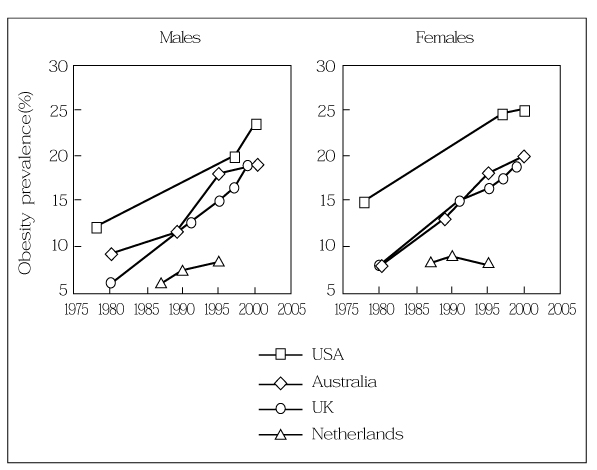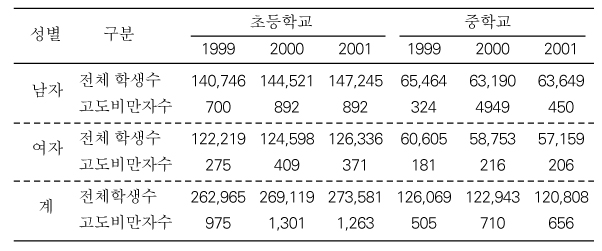 |
 |
- Search
| J Korean Med Assoc > Volume 47(4); 2004 > Article |
Abstract
Obesity can be defined as the excessive accumulation of fat in adipose tissues, to the extent that health may be impaired. The most widely used measures of total and abdominal adiposity are the body mass index (BMI) and waist circumference, respectively. During the past several decades, the prevalence of obesity has increased substantially, making it a true epidemic and a public health crisis, with about 315 million people world-wide estimated to fall into the WHO-defined obesity categories with BMI of 30 or above. Indeed, the obesity epidemic has been already leading to dramatic increases in type 2 diabetes and metabolic syndromes. On the other hand, there are substantial risks for morbidity in obese children even before they reach adulthood, and if obesity in childhood persists into the adult years, the morbidity and mortality are greater than if the obesity developed in adulthood. The major causes of the rapid global rise in obesity rates lie in the profound environmental and societal changes now affecting large parts of the world and creating societies in which physical activities are low and the availability of high-fat, energy-dense foods has increased. Strategies aimed at preventing weight gain and obesity are likely to be more cost effective and to have a greater positive impact on the long-term control of body weight than treating obesity once it has developed.
References
1. Obesity : Preventing and Managing the Global Epidemic 2000;Geneva: World Health Organization. 256.
2. Garrow JS. Obesity and Related Diseases 1988;Edinburgh: Churchill Livingstone.
3. Physical Status : the Use and Interpretation of Anthropometry 1995;Geneva: World Health Organization. 329.
4. Deurenberg P. Universal cut-off points for obesity are not appropriate. British Journal of Nutrition 2001;85:135-136.
5. In: James WPT, Chuming Chen, Inoui S, editor. Appropriate Asian body mass indices. Obesity Reviews 2002;3:139.
7. Zhou Bei-Fan. Predictive values of body mass index and waist circumference for risk factors of certain related diseases in Chinese Adults-Study on optimal cut-off points of body mass index and waist circumference in Chinese adults. Biomedical and Environmental Sciences 2002;15:83-96.
8. WHO Working Group. Use and interpretation of anthropometric indicators of nutritional status. Bulletin of the World Health Organization 1986;64:929-941.
9. Hammer LD, Kraemer HC, Wilson DM. Standardised percentile curves of body mass index for children and adolescents. American Journal of Diseases of Children 1991;145:259-263.
10. Must A, Dallal GE, Dietz WH. Reference data for obesity: 85th and 95th percentiles of body mass index and triceps skinfold thickness. American Journal of Clinical Nutrition 1991;53:839-846.
11. Cole TJ, Bellizzi MC, Flegal KM, Dietz WC. Establishing a standard definition for child overweight and obesity world-wide: international survey. British Medical Journal 2000;320:1240-1243.
12. Trakas K, Lawrence K, Shear NH. Utilisation of health care resources by obese Canadians. Canadian Medical Association Journal 1999;160:1457-1462.
13. Nutrition Section, Controlling the Global Obesity Epidemic. World Health Organization Available from: http://www.who.int/nut/obs.htm
14. Dunstan D, Zimmet P, Welborn T. Diabesity and Associated Disorders in Australia. Final Report of the Australian Diabetes, Obesity and Lifestyle Study (AUSDIAB) 2001;Melbourne: International Diabetes Institute.
15. Prevalence of Overweight and Obesity Among Adults : United States, Centers for Disease Control and Prevention 1999;Atlanta: National Center for Health Statistics.
16. Lissner L, Johansson SE, Qvist J. Social mapping of the epidemic in Sweden. International Journal of Obesity 2000;24:801-805.
17. Heitmann BL. Ten-year trends in overweight and obesity among Danish men and women aged 30-60 years. International Journal of Obesity 2000;24:1347-1352.
18. Lahti-Koski M, Vartianen E, Mannisto S, Pietinen P. Age, education and occupation as determinants of trends in body mass index in Finland from 1982 to 1997. International Journal of Obesity 2000;24:1669-1676.
19. Flegal KM, Carroll MD, Kuczmarski RJ, Johnson CL. Overweight and obesity in the United States: prevalence and trends. 1960 1994. International Journal of Obesity and Related Metabolic Disorders 1998;22:39-34.
20. Molarius A, Seidell JC, Sans S, Tuomilehto J, Kuulasmaa K. Waist and hip circumferences, and waist-hip ratio in 19 populations of the WHO MONICA Project. International journal of obesity and related metabolic disorders 1999;23:116-125.
23. Martorell R, Kettel-Khan L, Hughes ML, Strawn LMG. Overweight and obesity in preschool children from developing countries. International Journal of Obesity 2000;24:959-967.
- TOOLS
-
METRICS

-
- 2 Crossref
- Scopus
- 1,137 View
- 14 Download
-
Related articles in
J Korean Med Assoc -
Pathogenesis and epidemiology of chronic subdural hematoma2024 June;67(6)
Current status and epidemiology of adult obesity in Korea2022 July;65(7)
Etiology and epidemiology of neuropathic pain2021 July;64(7)
Etiology and epidemiology of spinal cord injury in Korea2020 October;63(10)












